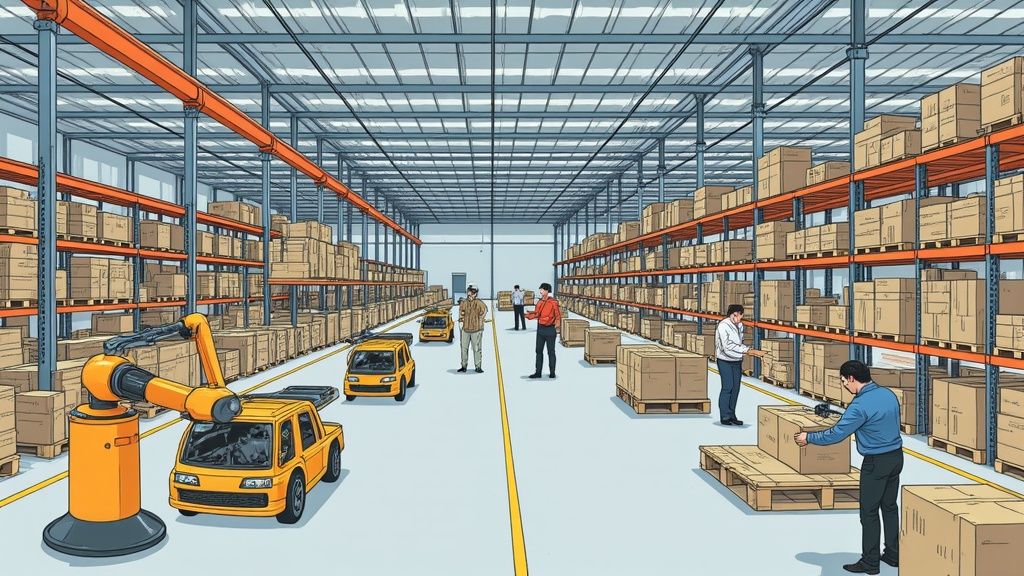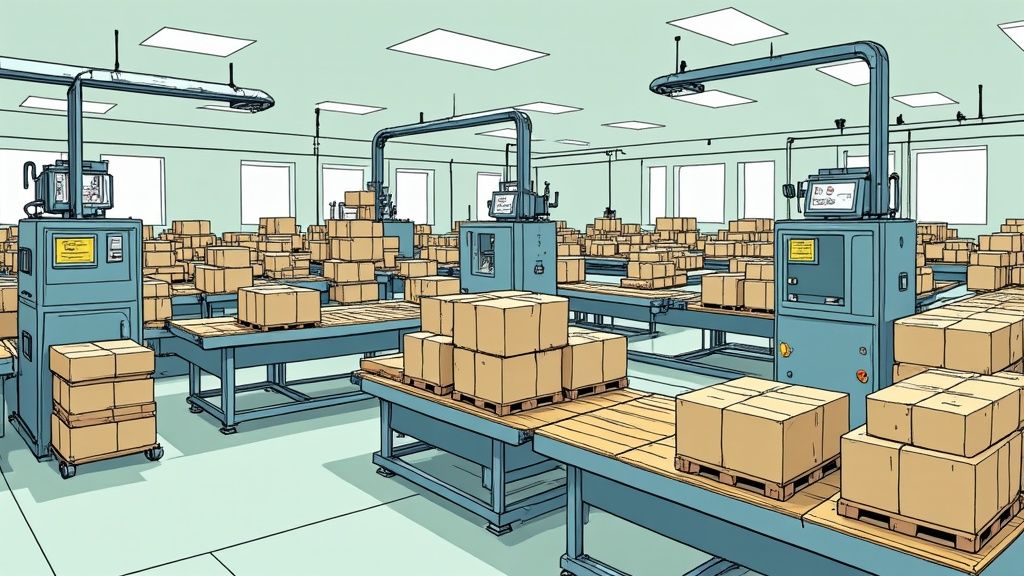Getting Started with Amazon Automation

Starting to automate your Amazon business might seem like a big task at first. But with the right approach, you can make meaningful progress step by step. The key is understanding which parts of your business could benefit most from automation. Think of it like setting up systems that handle routine tasks while you focus on growing your business.
Identifying Automation Opportunities
Take a close look at your daily operations. Which tasks eat up most of your time? What work feels repetitive? These are the first places to consider automating. For example, many sellers spend hours tracking inventory levels and placing restock orders manually. Using inventory management software can free up this time and reduce mistakes.
Customer service is another area where automation makes sense. Simple tools can handle common questions, shipping updates, and feedback requests automatically. This lets your team spend more time helping customers with complex issues that need a personal touch.
Building Your Automation Roadmap
After spotting opportunities to automate, prioritize them based on impact and ease of implementation. Start with simpler projects that will give you quick wins. For example, set up automated inventory alerts before overhauling your entire customer service system. This builds momentum for bigger changes later.
Choosing the right tools is essential. Services like Amazon Q can automate workflows effectively. Amazon’s built-in tools for automated pricing and shipping settings help manage key sales processes. And companies like eStore Factory can guide you through optimizing your automation strategy on Amazon.
Overcoming Initial Challenges
The path to automation isn’t always smooth. Your team might resist changes at first, or you could run into technical issues connecting different systems. See these bumps as chances to learn and improve. Many sellers struggle early on with integrating new software – this is normal. Good training and careful attention to data transfer between systems can help avoid major issues.
Success with Amazon automation comes down to smart planning and consistent follow-through. By focusing on high-impact projects, using appropriate tools, and working through challenges systematically, you can improve your operations and help your business grow steadily over time.
Building Your Automation Framework
Setting up automation for your Amazon business needs careful planning to work effectively with your current operations. A well-designed framework helps your business grow steadily while making daily tasks easier to manage.
Key Considerations for Amazon Automation Business Framework
When building your framework, start by looking at which tasks will benefit most from automation. Review your daily operations and identify repetitive work that takes up too much time or is prone to mistakes. Common examples include managing inventory levels, processing orders, and handling customer service messages. By focusing on these key areas first, you’ll get the most impact from your automation efforts.
Choosing the right tools is another crucial step. You’ll find everything from basic task automation software to complete business management platforms. eStore Factory helps sellers pick and set up automation tools that match their specific needs. Make sure any tools you choose work smoothly with your current systems, especially your Amazon Seller Central account, to avoid technical problems down the line.
Balancing Costs and Benefits
While automation can bring major improvements, it’s important to weigh the costs carefully. Consider both the initial setup costs and ongoing expenses for maintenance and support. Compare these costs to the expected benefits before deciding which automation projects to tackle first. For example, investing in inventory management software might cost more upfront but can save money by preventing stockouts and reducing storage fees.
Maintaining Quality While Scaling
As your automated systems handle more tasks, keeping quality consistent becomes more important. While automation helps reduce errors, you need clear quality control measures in place. Set up regular checks of your automated processes, track key metrics, and look for areas that need improvement. For instance, regularly review automated customer service responses to catch and fix any issues before they affect customer satisfaction. This focus on quality helps build trust with customers as your business grows.
Framework Implementation and Measurement
Put your framework into action step by step. First, write down each process you want to automate and break it into smaller tasks. Then plan how automation tools will handle each task for the best results. Finally, decide how you’ll measure success – this could include tracking order processing speed, customer feedback scores, or how quickly inventory moves. Check these measurements regularly to see how well your automation is working and make adjustments as needed.
By taking this organized approach to automation – focusing on the right processes, picking suitable tools, and maintaining quality – you can use automation effectively to grow your Amazon business for the long term.
Mastering Inventory and Supply Chain Automation
Running a successful Amazon business requires skillful inventory management. More than just tracking stock levels, it’s about anticipating customer needs, optimizing storage space, and creating a smooth flow from supplier to buyer. When handled strategically, automation can help master these essential elements.
Predictive Analytics for Smarter Stock Levels
Getting stock levels right can make or break your business. Modern analytics tools examine your past sales data, seasonal patterns, and market indicators to project future demand with impressive accuracy. This means you can plan ahead – if sales data shows beach umbrellas spike every June, you’ll know to place orders in April so you’re fully stocked when customers start shopping. These data-driven insights help prevent both overstocking and stockouts.
Automating Supplier Communications
Clear communication with suppliers keeps your business running smoothly. However managing purchase orders, tracking shipments, and handling issues manually drains time and resources. An automated system can handle routine tasks – sending purchase orders when inventory drops below set levels, monitoring shipment status in real-time, and flagging potential delays. This proactive approach helps maintain optimal stock without constant oversight. For Amazon sellers looking to automate these processes, eStore Factory offers specialized support.
Optimizing Warehouse Operations
Your warehouse directly impacts customer satisfaction and business costs. The right automation tools – from robotic picking systems to smart conveyor belts – can significantly boost efficiency. These systems help maximize storage space, reduce errors, and speed up order processing. The result? Orders shipped faster, lower operational costs, and happier customers receive their items sooner.
Building a Resilient Supply Chain
Supply chains face many potential disruptions, from weather events to global transportation issues. Building resilience means having backup plans and the ability to adapt quickly when problems arise. Real-time tracking and multiple supplier relationships give you options when issues occur. This flexibility helps ensure consistent inventory flow and reliable order fulfillment, even during challenging times.
Customer Service and Feedback Automation

Now that you’ve optimized your inventory and supply chain operations, it’s time to focus on another key area – customer service and feedback management. The way you handle customer interactions directly affects satisfaction levels and sales. Smart automation helps you scale up while keeping that personal touch customers appreciate.
Automating Routine Customer Interactions
Most customer service questions follow common patterns – tracking orders, basic product info, and return policies. Setting up automation for these frequent requests lets your team focus on more complex issues that need human attention. For instance, when someone asks about their delivery status, they can get instant tracking details through automated email responses. You can also create automated answers for common product questions, which significantly reduces the workload on your support team.
Managing Feedback at Scale
As your business grows, you’ll get more customer feedback that becomes harder to handle manually. Good automation tools help collect and analyze feedback effectively while making it easier to respond to customers. You can automatically request product reviews to boost your visibility on Amazon. These tools also spot trends in customer comments – if multiple people mention the same product issue, the system flags it for quick action.
Maintaining the Human Element
While automation saves time and effort, customers still need that human connection, especially when dealing with complicated problems or complaints. The key is finding the right mix – use automation for simple tasks but have real people handle complex situations. This approach ensures quick responses for basic questions while giving personal attention where it matters most.
Building Systems for Improved Satisfaction
At its core, customer service automation aims to make customers happier with their experience. Quick responses, proactive support, and smooth issue resolution help build customer loyalty. For example, sending automated follow-up emails after purchases shows you care about their satisfaction and builds trust. eStore Factory helps Amazon sellers create automated systems that lead to better reviews and repeat business. When done right, this kind of automation builds lasting customer relationships that help your Amazon business thrive.
Scaling Through Strategic Automation
Running a successful Amazon business requires more than just automating individual tasks – it’s about strategically scaling your entire operation. Like building a well-oiled machine, each component needs to work together smoothly to deliver the best results. Let’s explore how to identify key growth areas and use automation effectively while maintaining quality and profitability.
Identifying Growth Opportunities
The first step in scaling is finding the right opportunities to expand. Here are some key areas to consider:
- Product Diversification: Look for natural ways to expand your product line. For example, if you sell phone accessories successfully, you might branch into related items like smartwatches or headphones that appeal to the same customer base.
- Market Penetration: Increase your share of existing markets through focused marketing and smart pricing strategies that help you reach more customers.
- Geographic Expansion: Tap into new customer segments by expanding to different regions or countries through Amazon’s global marketplace.
Automating Marketing and Pricing for Scale
Once you spot promising opportunities, automation becomes essential for efficient growth. Here’s how to automate key marketing functions:
- Targeted Advertising: Use Amazon Advertising to run automated campaigns that reach specific customer segments based on their demographics, interests, and past purchases.
- Email Marketing: Set up automated email sequences to nurture leads, promote new products, and stay connected with existing customers.
- Social Media: Schedule posts, track mentions and analyze performance automatically so your team can focus on meaningful customer engagement.
For pricing, automation helps you stay competitive and maximize profits:
- Smart Repricing: Use tools that automatically adjust prices based on competitor data, demand changes, and your target margins. This keeps you competitive without constant manual updates.
Optimizing for Profitability and Quality
To scale successfully, you need to balance growth with profitability while maintaining consistent quality. Focus on:
- Efficient Operations: Choose automation tools that streamline your entire workflow from inventory to customer service. eStore Factory can help select and integrate the right tools for your needs.
- Performance Tracking: Monitor key metrics like conversion rates, margins, and customer satisfaction to spot improvement areas and ensure your automation delivers results.
- Quality Control: Build automated quality checks throughout your supply chain with product inspections, supplier evaluations, and customer feedback analysis to maintain standards as you grow.
By thoughtfully combining growth strategies, marketing automation, and operational efficiency, you can build an Amazon business ready for sustainable long-term success. This balanced approach lets you seize market opportunities and optimize resources while achieving your business goals.
Future-Proofing Your Automated Amazon Business

Setting up automation is just the beginning of running a successful Amazon business. As the marketplace keeps changing with new tools and shopping habits, you need to plan to stay competitive. This means understanding upcoming changes and adapting your systems before they become outdated.
Making the Most of New Tools
AI and machine learning are reshaping how Amazon’s businesses operate. These tools help predict inventory needs more accurately than traditional methods, reducing stockouts and storage costs. They also enable chatbots to handle basic customer questions, giving your team more time for complex issues. For example, when Amazon added robots to its warehouses, workplace incidents dropped 15% while creating 700 new types of jobs. The goal isn’t to replace people but to help them work smarter using data.
Creating Flexible Systems
Your automation setup needs room to grow and change. Think of it like building blocks – you want pieces that fit together in different ways as your needs evolve. Choose tools that work well with others instead of all-in-one solutions that lock you in. This lets you test new approaches without starting over. When a new way to reach customers comes along, you can simply plug it into your existing workflow.
Staying Ahead of Changes
To keep your edge in a busy marketplace, you need to keep learning and adjusting. Stay current by going to industry events, reading seller forums, and connecting with other Amazon entrepreneurs. This helps you spot market shifts early so you can update your automation before falling behind. Understanding Amazon’s search ranking updates, for instance, helps you adjust your product listings to maintain visibility.
Working with Expert Help
Running an automated Amazon business gets complex as you grow. Having guidance from experienced pros like eStore Factory can make a big difference. They help pick and set up the right tools, improve your processes, and keep you informed about important changes. Their knowledge frees up your time to focus on growth, similar to how Amazon’s robotics investment helped scale their operations.
Ready to build an Amazon business that lasts? Contact eStore Factory today to learn how their team can help create an automated system that grows with you. Click here to learn more.

